Karen Mahony and Alex Ukolov of Baba Studio, Part 2
In part one of this article, Karen Mahony and Alex Ukolov let me in on their history as artists and as Tarot deck designers. They discussed their debut deck, the Tarot of Prague, as well as the Baroque Bohemian Cats' Tarot, the Fairytale Tarot, the Fantastic Menagerie Tarot, and the Victorian Flower Oracle.
Part two begins with their creation of another innovative deck that has become iconic: the Victorian Romantic Tarot. This deck is based on Victorian era mass-produced illustrations, mostly engravings and etchings. Some were created as illustrations, others as copies of paintings and other artworks, since in the days before photography, if you wished to print a picture of a painting in a book or magazine, an engraving or etching had to be made.

Why Victorian engravings? “I just appreciated the amount of art skills in this style,” Alex explained. “So I sort of rediscovered this style. I realized that artists in this style are more imaginative than these days. When you look at this art, the artists are very different, but the amount of skill they put into this art was exceptional. You can see that people had studied art for a long time to be able to produce this work. For me it was an honor to be introduced to this great amount of art which I didn’t know about. And I wanted to revive this, and give it new life. I really like the idea of eco-design, when you don’t throw away stuff, but you learn it and make it new.”
“It’s desperately unfashionable, this kind of Victorian realistic stuff,” Karen agreed. “So it was nice to rediscover it.”

This is not one of Baba's copies!
 As Karen sometimes points out, the popularity of engravings in the Victorian era means this kind of art was completely familiar to Arthur Edward Waite and to Pamela Colman Smith, the designers of the RWS Tarot, giving the Magic Realist team an opportunity to revisit the RWS images in the prevailing style of their time.
As Karen sometimes points out, the popularity of engravings in the Victorian era means this kind of art was completely familiar to Arthur Edward Waite and to Pamela Colman Smith, the designers of the RWS Tarot, giving the Magic Realist team an opportunity to revisit the RWS images in the prevailing style of their time.To gather engravings, Karen and Alex went to antique shops and bookshops and looked for bound volumes of Moderne Kunst and similar periodicals. Then they went through them painstakingly, marking the engravings they thought might be useful for individual cards. They didn’t have any preconceptions about what to choose, but there was one principle they followed. “We tried to avoid images that people would know very well, where they’d think ‘oh, they’ve changed that,’ Karen said. “So a lot of the stuff we used is quite obscure, although sometimes they were quite well known at the time.”
 Once the images were selected, the real work began. Although the deck was entirely based on old pictures, it wasn’t just a matter of finding them. “What some people don’t understand is that the card images were sometimes taken entirely to pieces and then re-pieced together. People actually imagine that we just found an engraving that happened to look like a Tarot card. Sometimes we did, but usually there was much more compilation.” In addition, they colored each image digitally to achieve the proper meaning and mood.
Once the images were selected, the real work began. Although the deck was entirely based on old pictures, it wasn’t just a matter of finding them. “What some people don’t understand is that the card images were sometimes taken entirely to pieces and then re-pieced together. People actually imagine that we just found an engraving that happened to look like a Tarot card. Sometimes we did, but usually there was much more compilation.” In addition, they colored each image digitally to achieve the proper meaning and mood. Although the deck contains artwork on every imaginable theme, from music and art to work and war, they explored a few themes in depth. For one, they were concerned about the depiction of women in Victorian art. The era was not as prudish as its reputation, and consequently there was a lot of sensuous and erotically charged artwork to choose from. But Karen and Alex made a conscious decision not to use art that depicted women objectified or victimized, except in cases where this is necessary to the Tarot meaning. The result is a deck in which women’s physicality and sexuality are depicted with both dignity and joy.
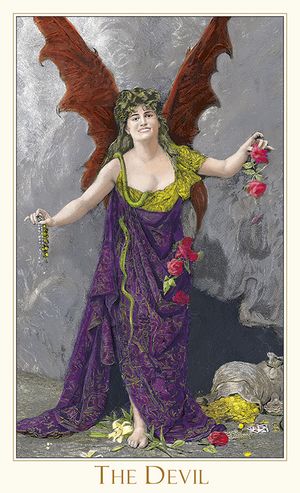 The Baba team also incorporated cards showing many of the artistic and cultural concerns of the time, from the fad for ancient Egypt to the popularity of the circus, and from classicism to the industrial revolution. One theme they flirted with throughout the deck was the Gothic impulse in art and storytelling. Somnambulists teetering on rooftops, drowning sailors lashed to the mast, skeletons watching from corners, and ladies languishing in gardens peep around the edges of this deck, adding a touch of the uncanny to the otherwise brightly-colored and realistic artwork.
The Baba team also incorporated cards showing many of the artistic and cultural concerns of the time, from the fad for ancient Egypt to the popularity of the circus, and from classicism to the industrial revolution. One theme they flirted with throughout the deck was the Gothic impulse in art and storytelling. Somnambulists teetering on rooftops, drowning sailors lashed to the mast, skeletons watching from corners, and ladies languishing in gardens peep around the edges of this deck, adding a touch of the uncanny to the otherwise brightly-colored and realistic artwork. The Victorian Romantic Tarot caused a sensation in the Tarot world, being declared Deck of the Year and an instant classic by various of the Tarot intelligentsia. It was so popular that Baba began to develop a cult following among Tarot fans. Because of this, their follow-up deck was one of the most anticipated Tarot decks in many years.
It was the Gothic strain in the Victorian Romantic Tarot that got Karen thinking about this next deck, which would come to be called the Bohemian Gothic Tarot. “While we were doing the Victorian Romantic Tarot, I got the idea of doing the Bohemian Gothic Tarot,” she remembered. “I made a sort of throwaway comment on an online forum about it being the “Dark Sister,” and everybody sort of jumped on that,” Karen remembered. Soon fans were clamoring for the “Dark Sister,” although the name was quickly dropped. Still, Karen sees the name as appropriate. “In a way it really is the Dark Sister,” she said, “because it was born from the same era of art.”
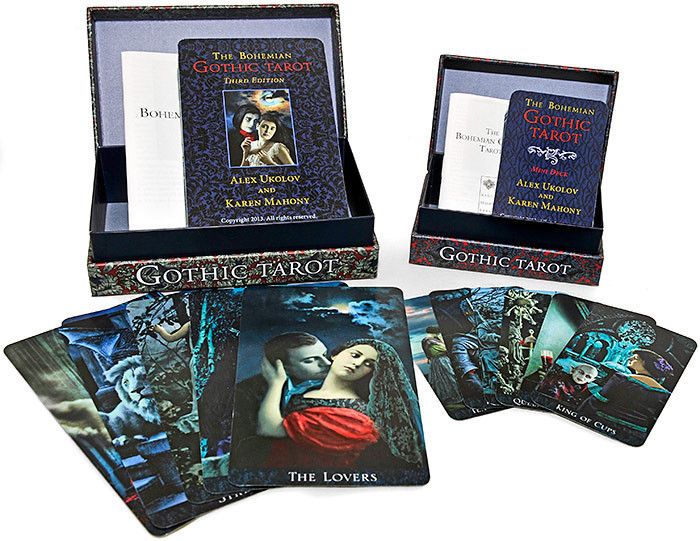
Doing a deck based on the Gothic and the uncanny, the roots of modern horror fiction, was again Karen’s idea. Her love of such themes goes back to her early life. “Ireland is quite a dark place in some ways,” she explained. “I remember when I was about fifteen, a friend taking me to see a famine graveyard. It wasn’t well kept, and there were human bones lying on top of the soil that had worked their way through. And I remember that being the most profoundly disturbing experience. Seeing these graveyards with entire families all dead in a year. Ireland is steeped in that kind of thing.” Indeed, the Irish upbringing of Bram Stoker and Joseph Sheridan Le Fanu was a major influence on Dracula and Carmilla, and thus on all of Gothic horror.

1916 drawing of Sheridan Le Fanu
The deck almost didn’t happen, however, because the idea didn’t appeal to Alex. “The Soviet Union experience and the Western European experience were very different,” Karen explained, “so Alex didn’t go through the era I went through with Hammer Horror films, and the fascination with horror. As far as I know, the Soviet Union that didn’t really exist. It wasn’t something anyone was interested in.”
Because of this, Alex initially said no to the idea. “I imagined blood everywhere. Teeth. This horror…I didn’t like it,” he said. “Until we decided we’d do it in a subtle way. More of a Hitchcock style, like the expectation of something about to happen, instead of showing the act.” This was an easy concession for Karen to make, since it comported well with her taste too. “I don’t like modern slasher horror type of stuff, and I don’t like the tendency of modern vampire movies to show a lot of blood and guts,” she said.
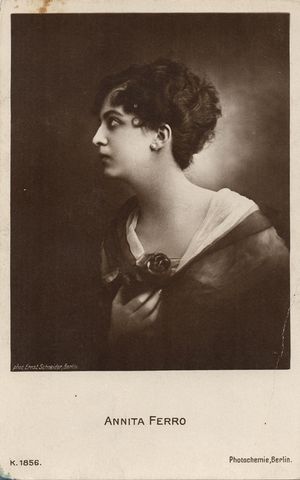
Cabinet card used in the Bohemian Gothic Tarot
Another thing that argued for using cabinet card photographs for the central images was the team’s inability to achieve the same feel with their own photography. “We tried to incorporate modern people, photographed into these old-style interiors and exteriors,” Alex recalled, “and it didn’t work. We realized very quickly that modern people look very different. It’s not that we’re a different kind of human, but our expressions are just very different. So we decided that we can’t use modern photographs. But that gives you an interesting sort of shift, so you can see that they’re people and you can recognize and relate, but also they’re different.”
This doesn’t mean their own photographs weren’t an integral part of the deck. Because they had to depict people in certain situations, holding certain objects such as swords or cups, it was often necessary to replace various body parts with new photographs. “We did an awful lot of photography ourselves on the Bohemian Gothic Tarot,” Karen remembered. “But it tended to be hands, necks, shoulders. Alex is terrible for saying, ‘can I just photograph your hands while you’re here?’ And next thing, you’re on a Tarot card!”
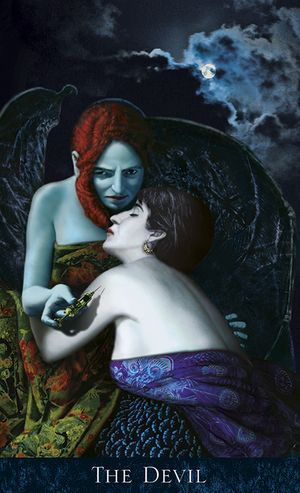 “People who are not illustrators, they don’t really understand what they’re seeing,” she continued. “So one of the comments we had from a person who doesn’t like the Bohemian Gothic Tarot is ‘it must be awful for people to see their grandparents’ photographs transformed into monsters.’ Well, not many of the photographs would be very recognizable, actually. Take the Devil card. It’s based on a very disturbing picture, but we sort of reconstructed it. The Devil itself, unusually for this deck, was based on the face of someone we were working with at the time. I’m the back of the person that the Devil is injecting. The fabric came from somewhere else. The hands came from a friend.”
“People who are not illustrators, they don’t really understand what they’re seeing,” she continued. “So one of the comments we had from a person who doesn’t like the Bohemian Gothic Tarot is ‘it must be awful for people to see their grandparents’ photographs transformed into monsters.’ Well, not many of the photographs would be very recognizable, actually. Take the Devil card. It’s based on a very disturbing picture, but we sort of reconstructed it. The Devil itself, unusually for this deck, was based on the face of someone we were working with at the time. I’m the back of the person that the Devil is injecting. The fabric came from somewhere else. The hands came from a friend.”Originally, the idea was to make it a survey of known Gothic stories. “We had talked about doing a scene in Carmilla, and a scene in Dracula, and a scene in Frankenstein, and we decided that that wasn’t going to work,” Karen said. “So they’re all sort of references.”
 As an example, Karen points to the Queen of Swords. “Most people don’t get that it’s a reference to Carmilla,” she said, “because most people haven’t read Carmilla, which is the first really good vampire story. The incredibly long hair is a distinctive feature of Carmilla herself. So it’s just a reference that some people will pick up. And if they don’t pick it up they’ll still get that it’s some kind of strange vampire figure surrounded by bones.”
As an example, Karen points to the Queen of Swords. “Most people don’t get that it’s a reference to Carmilla,” she said, “because most people haven’t read Carmilla, which is the first really good vampire story. The incredibly long hair is a distinctive feature of Carmilla herself. So it’s just a reference that some people will pick up. And if they don’t pick it up they’ll still get that it’s some kind of strange vampire figure surrounded by bones.”“We didn’t want people to have to read an awful lot,” she continued. “We’d seen one or two literary Tarots, and we’d thought that the problem was that they assumed that people had read all the stuff, and the fact is that an awful lot of people probably don’t. So we thought if we seriously were saying to people you’ve got to read several dozen Victorian gothic novels, that’s not going to happen. And I think with Gothic it’s not necessary…they can see Dracula or Frankenstein or Jekyll and Hyde, and they have enough associations for it to work.”
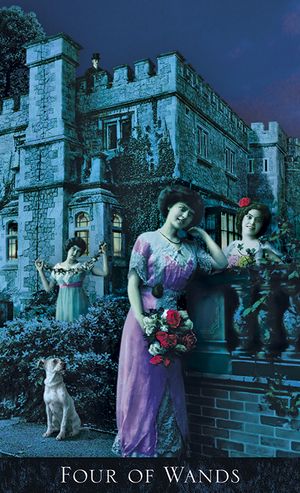 In the end, many of the cards don’t refer to specific stories, but to the general atmosphere of the Gothic. It has its share of ghosts, mummies, vampires, and werewolves, but it also has cards where the horror is more subtle, cards featuring children with haunted expressions and mysterious women on windswept moors. “The Four of Wands has women walking out away from a house and you notice there’s a man watching them,” Karen said. “It’s very reminiscent of all these horror stories where people think they’re free but they’re not, they’re being watched and controlled.” She also mentions that many cards suggest dysfunctional or disturbing family dynamics, a theme which runs through Gothic literature from The Castle of Otranto to The Fall of the House of Usher, and on to more modern works.
In the end, many of the cards don’t refer to specific stories, but to the general atmosphere of the Gothic. It has its share of ghosts, mummies, vampires, and werewolves, but it also has cards where the horror is more subtle, cards featuring children with haunted expressions and mysterious women on windswept moors. “The Four of Wands has women walking out away from a house and you notice there’s a man watching them,” Karen said. “It’s very reminiscent of all these horror stories where people think they’re free but they’re not, they’re being watched and controlled.” She also mentions that many cards suggest dysfunctional or disturbing family dynamics, a theme which runs through Gothic literature from The Castle of Otranto to The Fall of the House of Usher, and on to more modern works. The deck was difficult to complete. Just as Karen had fallen ill while working
The deck was difficult to complete. Just as Karen had fallen ill while workingon the Grandville decks, Alex fell ill toward the end of the Bohemian Gothic Tarot. But the strangest experience was Karen’s. “I had a very odd experience of meeting somebody who had all the characteristics of a vampire,” she said. “I’ve never been able to work that out…whether I was simply so involved in the deck that I simply hallucinated it, or whether I sort of materialized something in a form that I was thinking about a lot of the time. It appeared in a very clichéd way: it was the vampire Lestat, from Anne Rice, weirdly enough. And he was there for two, three, four minutes.” Stranger still, she encountered Lestat in a public place, but when she asked other people who were there, no one else had seen him!

Aeclectic Tarot Forum's Top Ten for 2007

2007: two decks in 'Top Ten of All Time' at Aeclectic
“And for very little money,” Alex added. “It’s like shooting yourself in the foot!”
Being a small press has certain other advantages as well. One of the techniques they’ve used, both to satisfy their own creative impulses, and to increase sales on their decks, is to put some decks out in multiple limited editions with gold or silver accents, and to revise their decks with new cards when they reprint them. That way, diehard fans or those looking for a special gift can buy limited editions, followers can buy several standard editions, and more casual buyers can purchase the current edition. (The Limited Edition of their latest deck sold out in a matter of weeks, but limited editions of many of their decks can be found from time to time on ebay.)
Baba Studio's most recent deck is The Alice Tarot, released last month to an eager audience. Based on Lewis Carroll’s classic novels Alice’s Adventures in Wonderland and Through the Looking-Glass, the Alice deck is once again based on original photographs shot by Alex. “Alice uses all the technique of The Baroque Bohemian Cats’ Tarot, but much more sophisticated because our illustration technique has improved over the years,” Karen said.

In a way, the Alice deck combines elements of all their previous decks: Victorian literature, original costumes and photographs, fairytale elements, and famous engravings to use as models. And, of course, horror.
 You don’t think the Alice books are horrific? Maybe you haven’t read them carefully, Karen suggests. “I read Alice when I was about 8,” she explained. “And I remember whimpering in my bedroom, and thinking, ‘how could my parents have been so irresponsible as to leave this book where I could get my hands on it and read it?’ I was that terrified. I felt it was the most frightening thing I’d ever read and ever would read.”
You don’t think the Alice books are horrific? Maybe you haven’t read them carefully, Karen suggests. “I read Alice when I was about 8,” she explained. “And I remember whimpering in my bedroom, and thinking, ‘how could my parents have been so irresponsible as to leave this book where I could get my hands on it and read it?’ I was that terrified. I felt it was the most frightening thing I’d ever read and ever would read.” “I’ve said that to people,” she continued, “and they’ve said ‘how can you be afraid of Alice?’ Because they’ve seen the Disney bit, they haven’t actually read the books! They’re full of jokes about death, and everybody’s mad, and she’s constantly under threat.”

The Hierophant's smoking-cap!
They didn’t think they’d ever find a better model, for several reasons. “When I first met her even years ago, I thought she was very Alicey,” Karen explained. “Somebody remarked about her that she’s a twenty-first century girl with a nineteenth century face. She’s into theater, and she’s done a lot of drama. And we needed someone who would be very patient with Alex too! She was just a perfect Alice.”
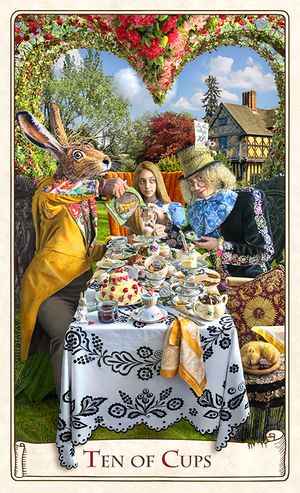 Karen also thought it was time to do Alice simply because Alex’s photography and illustration skills were up to the task. As Alex explained, it was slightly different from previous projects, even the Baroque Bohemian Cats’ Tarot. “Every project for me is a challenge,” he reminded me, “because all our decks are using different techniques. Some artists develop a style and do all their decks in that style. I get bored with that, because I like a challenge. So that was a challenge, even after the Bohemian Cats, which was more like animation, this was photographs of real people, real scales, real landscapes. Bohemian Cats was like puppet theater, but this is more like film work.”
Karen also thought it was time to do Alice simply because Alex’s photography and illustration skills were up to the task. As Alex explained, it was slightly different from previous projects, even the Baroque Bohemian Cats’ Tarot. “Every project for me is a challenge,” he reminded me, “because all our decks are using different techniques. Some artists develop a style and do all their decks in that style. I get bored with that, because I like a challenge. So that was a challenge, even after the Bohemian Cats, which was more like animation, this was photographs of real people, real scales, real landscapes. Bohemian Cats was like puppet theater, but this is more like film work.”Unlike the tiny costumes made for the Baroque Bohemian Cats’ Tarot, this deck featured full-sized costumes made by Romana Vojtíšková. “We’ve worked with her for eight years, and we never see her because she has her own little studio in North Bohemia,” Karen said. Vojtíšková designed some stunning clothes for the deck, including hooped dresses that transform people into chess pieces.
 Some costume elements were found rather than made: an Austro-Hungarian military uniform, for example, and exotic smoking-caps found in Czech antique shops. The Baba team also visited the Barrandov film studio, which rents costumes, and drew on individual contacts who make specialty items like boots and helmets. Karen made some items herself, including the White Rabbit’s waistcoat. “I made it on the flight to San Francisco, in the days when you used to be able to take needles and thread on flights. And it’s all made from old bits of English silk ties. I made that years and years ago, and I never knew why I made it!” The ruffled collar worn by the Mad Hatter was designed by the Baba team based on an old Swinburne poetry book paper, with teapot and teacup motifs added. “We’ve got a tendency to overdo things,” Karen confessed. “Probably no one will see that that’s got teacups on it!”
Some costume elements were found rather than made: an Austro-Hungarian military uniform, for example, and exotic smoking-caps found in Czech antique shops. The Baba team also visited the Barrandov film studio, which rents costumes, and drew on individual contacts who make specialty items like boots and helmets. Karen made some items herself, including the White Rabbit’s waistcoat. “I made it on the flight to San Francisco, in the days when you used to be able to take needles and thread on flights. And it’s all made from old bits of English silk ties. I made that years and years ago, and I never knew why I made it!” The ruffled collar worn by the Mad Hatter was designed by the Baba team based on an old Swinburne poetry book paper, with teapot and teacup motifs added. “We’ve got a tendency to overdo things,” Karen confessed. “Probably no one will see that that’s got teacups on it!”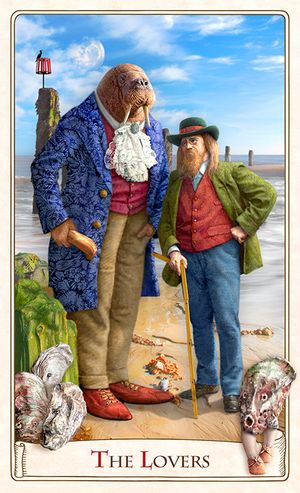 Alice was a challenging topic for a Tarot deck, particularly where some cards are concerned. “There are no lovers in the books,” Karen pointed out. “It’s one of the distinctive things about them: there are no romances. All the couples, they’re either completely indifferent or they hate each other.” As a result, their Lovers card features the Walrus and the Carpenter, two characters who are either best friends or duplicitous rivals in oyster gluttony, depending on whose interpretation you follow. Because this isn’t evocative for some Tarot readers, the Magic Realist team included an alternate card featuring two flamingos whose necks form the outline of a heart. Other notable cards include the Hierophant, featuring the trippy caterpillar smoking his hookah, Justice, featuring Carroll’s “Fury said to a mouse” poem, and the ten of cups, featuring the mad tea party.
Alice was a challenging topic for a Tarot deck, particularly where some cards are concerned. “There are no lovers in the books,” Karen pointed out. “It’s one of the distinctive things about them: there are no romances. All the couples, they’re either completely indifferent or they hate each other.” As a result, their Lovers card features the Walrus and the Carpenter, two characters who are either best friends or duplicitous rivals in oyster gluttony, depending on whose interpretation you follow. Because this isn’t evocative for some Tarot readers, the Magic Realist team included an alternate card featuring two flamingos whose necks form the outline of a heart. Other notable cards include the Hierophant, featuring the trippy caterpillar smoking his hookah, Justice, featuring Carroll’s “Fury said to a mouse” poem, and the ten of cups, featuring the mad tea party. 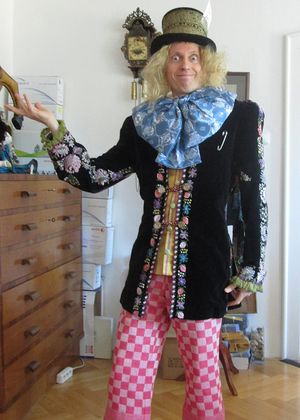
Alex is ready for an evening out!
“Some people won’t like the deck, because we haven’t romanticized it very much,” Karen said. “But it’s also very serious in terms of the symbolic, or, if you like, psychoanalytic content. I don’t know if everyone will realize that.”
(For more on my own impressions of The Alice Tarot, please visit my Huffington Post review of the deck!)
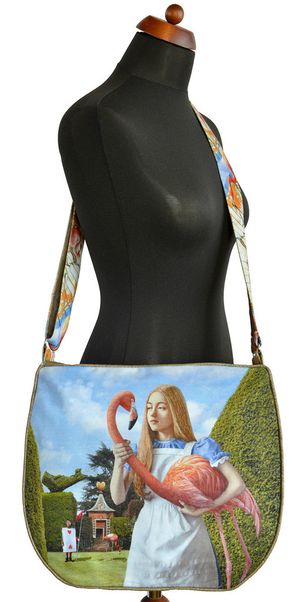 The Alice Tarot took much longer than they anticipated: they predicted a year’s work, but it took four and a half years. “All our decks are delayed,” Alex said. “It’s my fault, because being by nature a perfectionist, I can’t just let one go until I’m happy with it. And I’m never completely happy. I will always return to it to change something, until Karen takes it away and says, ‘Enough! Next one!’”
The Alice Tarot took much longer than they anticipated: they predicted a year’s work, but it took four and a half years. “All our decks are delayed,” Alex said. “It’s my fault, because being by nature a perfectionist, I can’t just let one go until I’m happy with it. And I’m never completely happy. I will always return to it to change something, until Karen takes it away and says, ‘Enough! Next one!’”So what will the next one be? They aren’t sure. They do know they’re taking at least a year off from Tarot. “I think the next thing is going to be jewelry and textiles,” Karen said. “We’re going to make clothes.”
Baba Studio has always sold gorgeous textile items, including Tarot bags, purses, and cushions, some of them based on their card designs. They also make and sell stunning scarves, wraps and corsets based on their Alice designs and on Art Nouveau and other European art movements. It was a lot of work to adapt designs intended for flat, rectangular paper so they would work on clothes, but the Baba team now has the hang of it…you can see for yourself here.
 But they have more clothing in store. “Our idol in terms of clothing is Alexander McQueen,” Karen said. “There’s no one like him. Alexander McQueen is the only person who’s got that level of insane detail. So that would be the idea, to get something even close to some of the amazing things that he did. We’re not there yet, but then on the other hand, his stuff is just frozen in time.”
But they have more clothing in store. “Our idol in terms of clothing is Alexander McQueen,” Karen said. “There’s no one like him. Alexander McQueen is the only person who’s got that level of insane detail. So that would be the idea, to get something even close to some of the amazing things that he did. We’re not there yet, but then on the other hand, his stuff is just frozen in time.” After a year of working on clothing designs, who knows? They might well get back into Tarot. But one thing they won’t do is adapt the work of an individual artist to Tarot cards. “We get asked all the time why we don’t do a William Waterhouse deck,” Karen said. “The issue when you’re working with a very well known piece of art, if you use it as-is, [for many cards] you’ll end up with something that really doesn’t fit the Tarot.” What she means is that most artists have created something that could fit The Lovers or The Devil. But The Tower or Judgment is less likely to be found among a given artist’s works, let alone the Five of Cups or Eight of Swords.
“The other thing you can do,” she continued, “is you can take them completely to pieces, which is the technique we used for the Victorian Romantic Tarot. And personally, I don’t want to take a William Waterhouse completely to pieces, because then it’s not William Waterhouse!”
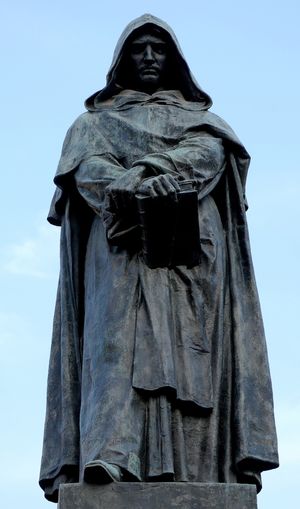
The statue of Giordano Bruno in Rome
This, too, goes with their chosen city. “Prague is just so steeped in magic, that it seems kind of an obvious thing to do,” she explained. “People here in Prague we find are very relaxed about magic. It would almost be like revising the Tarot of Prague, but in a very peculiar and different way.”
So is it a plan? Alex was ready with a firm “maybe.” “As a subject, it’s very interesting,” he said, “though I have no clue what it would look visually like. Another challenge!”
One nice feature of such a deck, but also possibly a public relations challenge, is that it would reverse the typical gender roles of Tarot. Karen and Alex already find that many people assume he is the one with a background in magic and Tarot. “I often get described as the marketing person,” Karen said ruefully.
This kind of thinking goes back in the Tarot community for many years. “The decks that have an occult system behind them tend to be done by men,” Karen explained. “The decks that don’t tend to be done by women. You see a really big split there.” Moreover, in the two best-known cases of collaboration on occult decks, Arthur Waite with Pamela Colman Smith and Aleister Crowley with Frieda Harris, the magical system was imposed by the man, while the pure illustration talent was provided by the woman. In Karen and Alex’s case, the opposite gender roles would apply. “I don’t know whether people would accept us doing something like that,” Karen said. “I think it would be kind of assumed that the magic side would be coming from Alex.”
Be that as it may, I think another deck from Magic Realist is in the cards. After all, thousands of Tarot readers can’t be wrong! “Professional Tarot readers come back to us and say that our decks work,” Alex said. “Which is a great thing to hear for us, because they’re not only visually attractive, but they can work. And I convinced myself, or got this idea, that it’s because we take this very seriously, and we’re very honest with the work we do. We don’t just do it quickly to be commercial, we do what we think should be there, and this makes a difference.”
“Be honest with your work,” he concluded, “and it will appeal to people.”
Note: In this article, all images of Baba Studio and Magic Realist Press products, including images of individual cards, are copyright Karen Mahony and Alex Ukolov, Baba Studio. The photo of the Giordano Bruno statue, the drawing of Le Fanu, and the cabinet card photograph are in the Public Domain. The photo of Steve Winick in the smoking cap and the photo of Alex in his Mad Hatter clothes are copyright Stephen Winick.
